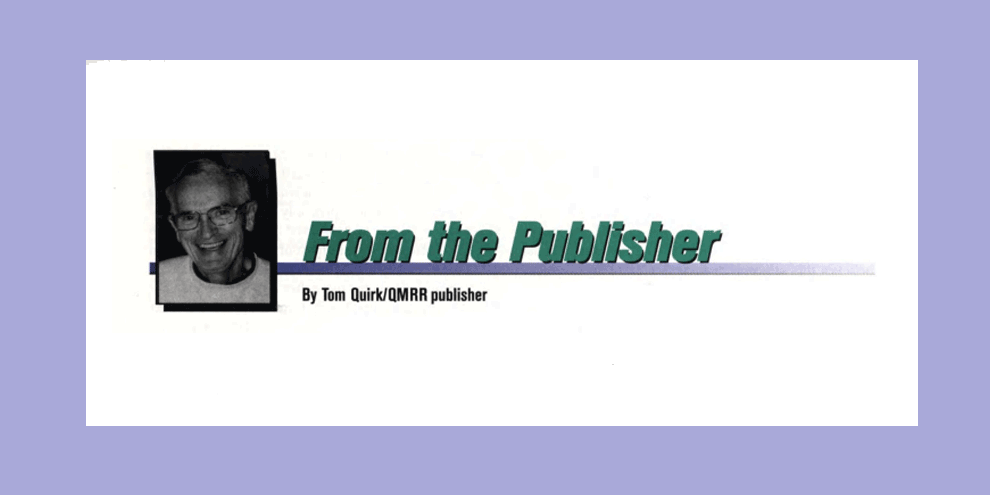On January 25th there was a story in Sally Beatty's advertising column in the Wall Street Journal concerning a new research program, "Just Ask a Woman," which Mary Lou Quinlan is launching. "Just Ask a Woman" is available for specific clients on a custom basis and is being positioned as the first "research" television talk show. Quinlan relinquished her position as CEO of N.W. Ayer, one of the country's largest advertising agencies, to start this venture.
The story captured my interest because Quinlan and co-host Ruth Ayres have a different philosophy about the methodology for collecting qualitative information.
In an interview last month, Quinlan told me she wants her groups not only to be spontaneous but also enthusiastic. She does not want to project herself as being dispassionate but rather would like the participants to view her as a "friend" who has empathy for them. Quinlan feels that women create a different audience when they are by themselves and more apt to express their true feelings when in a friendly environment.
The recruiters are told to look for extroverts and eliminate those who appear to be shy or introverted. Quinlan says the participants often get so enthused about what they have to say and how they want to express those feelings that they will take the microphone from her in order to have that moment of control. She wants the group to bond and believes one way is to have a larger number of participants, as many as 25-30. Because those invited tend to be outgoing, Quinlan encourages participation by arranging a studio-like setting with the cameras in full view. Rather than have the participants face each other as in a traditional focus group setting they are seated in rows of chairs, theater style. This requires the group to turn and twist if they wish to speak to other participants but it also insures that Quinlan or Ayres are the focus of attention. Quinlan believes this atmosphere increases participation rather than diminishing it.
The length of each session is about two-and-a-half hours, considerably more than the one to two hours in a traditional focus group. Quinlan says time is not a problem because the size of the group, their bonding, their enthusiasm, and the empathy they have for one another keep the program moving along at a lively pace. It's not unusual for the group to want to continue after the program has been completed, she says.
Because of the logistics involved, two sessions are usually held each day. Locations include television studios, hotels and universities. Although Quinlan did not provide cost estimates she did acknowledge that the charge for the custom sessions is considerably higher than it would be for traditional focus groups. She feels the extra cost can be justified because clients are provided with better information than what has been garnered previously using the more conventional methods.
Will this work? Is the use of larger groups the start of a new trend? How likely is it that we will be seeing focus groups on prime-time television? After viewing clips of sessions I have no doubt Quinlan is a talented individual who should be able to manage and run a talk show. This lady is enthusiastic and relates well with the participants. I found the clips interesting viewing - certainly better than 90 percent of what is presently being shown on television.
But is it research? Not as most of us would define that term. Between 1970 and 1986, the year this publication was started, I conducted more than 500 focus group sessions. During that period I never recall being asked to eliminate anyone who might be shy or introverted. Those individuals were considered to be just as important to my clients as the extroverts. It was my job as the moderator/facilitator to make each participant feel comfortable about expressing their opinion and let them know that whatever they said would be accepted. I don't know if they considered me a friend but I tried to make sure they saw me as a non-judgmental listener who wanted to hear from them. My clients also expected that they would hear from each of the eight to 10 participants. Even in some two-hour sessions it was difficult to get the full participation of all attendees. To get each of 25 to 30 attendees to express themselves, even after adding an extra half hour to the program, would be nearly impossible. The results of my meetings may not have qualified for prime time but they usually did meet the objectives the clients set for the projects.
Having said the above, I still wish Quinlan success in finding a television home for her program. It would be more interesting than most of the talk shows on TV and far superior to the sitcoms.
AI & Insight Innovations
Related Categories:
Research Industry, Qualitative Research, Focus Groups Research Industry, Qualitative Research, Focus Groups, Artificial Intelligence / AI, Consumer Research, Data Analysis, Data Quality, Incentive Payment & Processing, Innovation, One-on-One (Depth) Interviews, Panels-Online
Research Industry, Qualitative Research, Focus Groups Research Industry, Qualitative Research, Focus Groups, Artificial Intelligence / AI, Consumer Research, Data Analysis, Data Quality, Incentive Payment & Processing, Innovation, One-on-One (Depth) Interviews, Panels-Online
